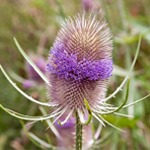What is an invasive species?
Invasive species are non-native plant and animal species that enter or “invade” a habitat and cause harm to the environment, economy, or human health. Invasive species (sometimes shortened to “invasives”) negatively impact ecosystems by disrupting native habitats, often by outcompeting and crowding out native plants. In many habitats, the invasive species are not subject to the natural checks and balances that control populations of native species.
How did they get here?
Invasive species can come to an area in many ways. They can be introduced as an ornamental plant, for food, or by accident. Many invasive plant species overshadow native species by having a longer seasonal growth cycle or being more aggressive than the native species that live in the same habitat.
How can we get rid of them?
Persistent control measures can remove invasive species. The Lake Champlain Land Trust and our dedicated volunteers are working hard to control invasive plants on our natural areas.
Learn More: Lake Champlain Land Trust Invasive Species Info Sheets
(Click for a downloadable and printable PDF)
 Buckthorn. Brought over from Europe as hedging material, Buckthorn is a shrub that grows on forest edges. It blooms early and keeps its leaves late into the fall, restricting the sunlight for native vegetation and preventing native trees and shrubs from growing in the understory.
Buckthorn. Brought over from Europe as hedging material, Buckthorn is a shrub that grows on forest edges. It blooms early and keeps its leaves late into the fall, restricting the sunlight for native vegetation and preventing native trees and shrubs from growing in the understory.
Common Teasel. Introduced from Europe, teasel is aggressive competitor that can produce thousands of seeds and form dense patches. Often found along roadsides, teasel is a persistent invader that can quickly crowd out native plants.
 Garlic Mustard. A biennial flowering plant for Europe and Western Asia, garlic mustard was brought over for food. It has escaped cultivation and is taking over forest ground-cover habitat. Garlic mustard also prevent beneficial soil bacteria from growing, negatively impacting nearly native plants.
Garlic Mustard. A biennial flowering plant for Europe and Western Asia, garlic mustard was brought over for food. It has escaped cultivation and is taking over forest ground-cover habitat. Garlic mustard also prevent beneficial soil bacteria from growing, negatively impacting nearly native plants.
 Honeysuckle. Native to parts of Asia, the honeysuckle shrub was brought to America as an ornamental. Their shallow and stretching roots and their long foliage period allow them to outcompete native vegetation.
Honeysuckle. Native to parts of Asia, the honeysuckle shrub was brought to America as an ornamental. Their shallow and stretching roots and their long foliage period allow them to outcompete native vegetation.
 Poison Parsnip. A root vegetable from Europe and Asia that has escaped cultivation, poison parsnip now takes over open fields and roadsides. The sap of this plant can be very poisonous. Exposure to the sap can result in skin boils, especially on sunny days.
Poison Parsnip. A root vegetable from Europe and Asia that has escaped cultivation, poison parsnip now takes over open fields and roadsides. The sap of this plant can be very poisonous. Exposure to the sap can result in skin boils, especially on sunny days.
 Purple Loosestrife. A purple flower native to Europe, purple loosestrife invades wetlands and ditches. It produces millions of seeds every summer and soon takes over the entire ecosystem, choking out other plants.
Purple Loosestrife. A purple flower native to Europe, purple loosestrife invades wetlands and ditches. It produces millions of seeds every summer and soon takes over the entire ecosystem, choking out other plants.
 Water Chestnut. From China, water chestnut is a persistent invader in the southern part of Lake Champlain. It provides little nutritional value and blocks sunlight from entering the lake since it grows as thick mats on the surface.
Water Chestnut. From China, water chestnut is a persistent invader in the southern part of Lake Champlain. It provides little nutritional value and blocks sunlight from entering the lake since it grows as thick mats on the surface.


